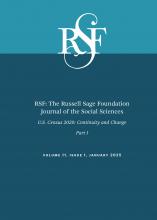Research Article
Open Access
U.S. Trends in Job Stability by Sex, Race, and Ethnicity from 1996 to 2020
Michael Lachanski
RSF: The Russell Sage Foundation Journal of the Social Sciences January 2025, 11 (1) 224-246; DOI: https://doi.org/10.7758/RSF.2025.11.1.11
Michael Lachanski
aDoctoral candidate at the Population Studies Center at the University of Pennsylvania, United States

REFERENCES
- ↵
- Alba, Richard
- ↵
- ↵
- Autor, David H
- ↵
- Autor, David H., and
- David Scarborough
- ↵
- Baum, Charles L
- ↵
- ↵
- Cai, Yong
- ↵
- Cappelli, Peter
- ↵
- Clark, Andrew E., and
- Anthony Lepinteur
- ↵
- ↵
- ↵
- Diebold, Francis X.,
- David Neumark, and
- Daniel Polsky
- ↵
- Eberstadt, Nicholas
- ↵
- ↵
- Farber, Henry S
- ↵
- Farber, Henry S
- ↵
- Farber, Henry S
- ↵
- Flood, Sarah,
- Miriam King,
- Renae Rodgers,
- Steven Ruggles,
- John R. Warren, and
- Michael Westberry
- ↵
- Goldin, Claudia, and
- Lawrence F. Katz
- ↵
- Hall, Matthew,
- Emily Greenman, and
- Youngmin Yi
- ↵
- Hall, Peter A., and
- David Soskice
- ↵
- Hall, Robert E
- ↵
- Halpern-Meekin, Sarah, and
- Adam Talkington
- ↵
- ↵
- Heisz, Andrew
- ↵
- ↵
- Hobbs, Frank
- ↵
- ↵
- Hollister, Matissa N., and
- Kristin E. Smith
- ↵
- Horiuchi, Shiro, and
- Samuel H. Preston
- ↵
- Hyatt, Henry R., and
- James R. Spletzer
- ↵
- Hyatt, Henry R., and
- James R. Spletzer
- ↵
- Jaeger, David A., and
- Ann H. Stevens
- ↵
- Jargowsky, Paul A
- ↵
- Kalleberg, Arne L
- ↵
- ↵
- Kaplan, Juliana, and
- Madison Hoff
- ↵
- Karabchuk, Tatiana
- ↵
- Keyfitz, Nathan, and
- Hal Caswell
- ↵
- ↵
- Lachanski, Michael
- ↵
- Lachanski, Michael
- ↵
- Lane, K. F. and
- Andrew, J. E
- ↵
- ↵
- ↵
- Molloy, Raven,
- Christopher Smith, and
- Abigail K. Wozniak
- ↵
- Murphy, Michael
- ↵
- Neumark, David
- ↵
- Neumark, David,
- Daniel Polsky, and
- David Hansen
- ↵
- ↵
- O’Reilly III, C.A.,
- Caldwell, D. F. and
- Barnett, W. P
- ↵
- Paxson, Christina H., and
- Nachum Sicherman
- ↵
- Preston, Samuel H
- ↵
- ↵
- Preston, Samuel H., and
- Ansley J. Coale
- ↵
- Preston, Samuel H.,
- Patrick Heuveline, and
- Michel Guillot
- ↵
- Pries, Michael J., and
- Richard Rogerson
- ↵
- Roberts, Anthony, and
- Roy Kwon
- ↵
- Schneider, David,
- Kristen Harknett, and
- Matthew Stimpson
- ↵
- Silcock, Herbert
- ↵
- St-Denis, Xavier
- ↵
- St-Denis, Xavier, and
- Matissa Hollister
- ↵
- Stewman, Shelby
- ↵
- Stone, Katherine V. W
- ↵
- ↵
- ↵
- ↵
- ↵
- Ureta, Manuelita
- ↵
- Wang, Xuening
- ↵
- Wilson, William J
- ↵
- Wilson, William J
- ↵
- Witt, Michael A. and
- Gregory Jackson
- ↵
- Wrigley-Field, Elizabeth, and
- Nathan Seltzer
In this issue
U.S. Trends in Job Stability by Sex, Race, and Ethnicity from 1996 to 2020
Michael Lachanski
RSF: The Russell Sage Foundation Journal of the Social Sciences Jan 2025, 11 (1) 224-246; DOI: 10.7758/RSF.2025.11.1.11





